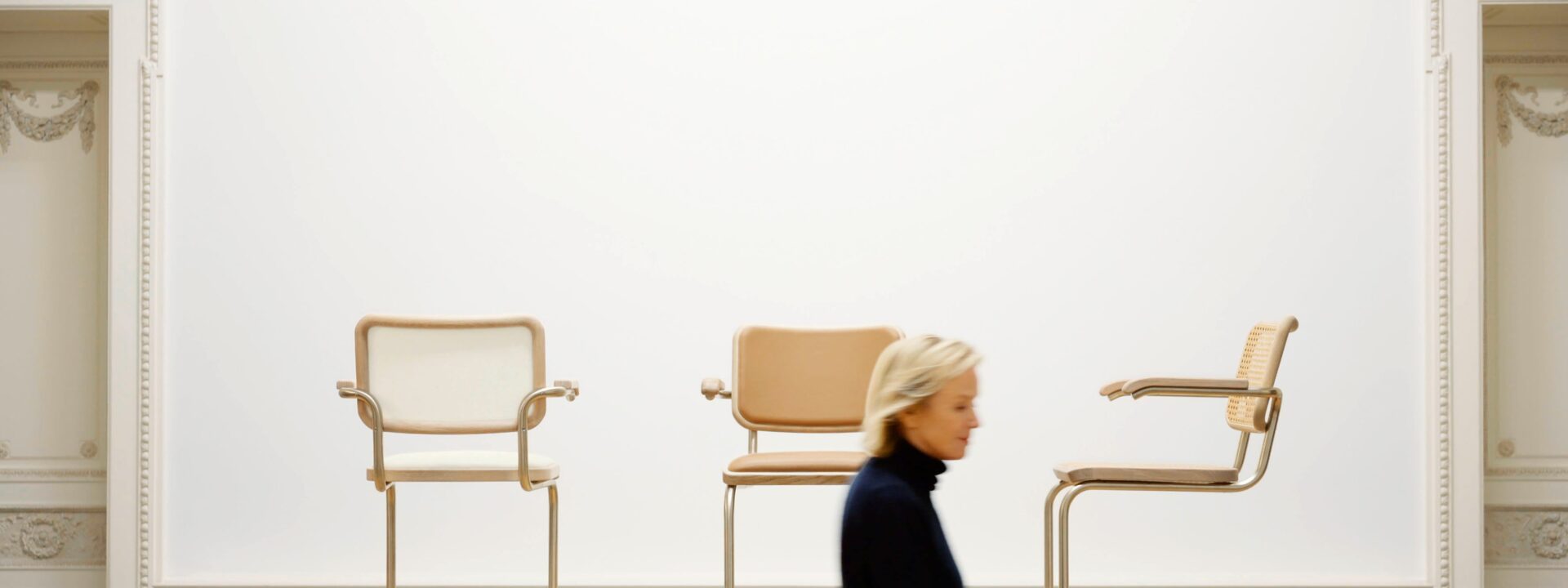I’m doing something I never thought I’d do: emailing Jil Sander. There’s a specific reason for this exchange. Sander—the legendary visionary behind purist, minimalist fashion, who stepped away from the industry years ago into a quiet, anonymous life, leaving her Uniqlo +J collection as a parting gift—has agreed to discuss her collaboration with the furniture maker Thonet. Like everything else in her long career, this project is deliberate and intentional.
Just unveiled at Milan Design Week (the annual event held alongside the Salone del Mobile furniture fair), JS.Thonet is the Hamburg-based designer’s reinterpretation of Thonet’s iconic tubular steel seating and side tables, originally designed by Marcel Breuer in the late 1920s. There are two versions: Nordic, with polished blonde wood accents, and Serious, with black lacquer. Both feature Viennese canework or leather upholstery.
Like so much of Jil Sander’s work—which has drawn a devoted following (myself included)—this project reimagines the familiar, infusing it with fresh urgency. (Think of how she elevated the white cotton poplin shirt to new heights while keeping it grounded.) Below is our conversation, unedited and direct—just as she prefers.
MH: How did this collaboration come about?
JS: Thonet approached me with the idea of reinterpreting Marcel Breuer’s cantilever chair. I visited their manufactory in Frankenberg, Germany, and explored the archives. The craftsmanship and attention to quality were impressive, so I enthusiastically agreed.
MH: What does Thonet mean to you?
JS: Thonet is a cornerstone of design history, dating back to the Biedermeier era. They evolved from bentwood to steel tube designs, working with Bauhaus masters like Breuer, Mies van der Rohe, and Le Corbusier. Their legacy is about modernity and pushing boundaries—something that aligns with my own design philosophy.
MH: Did you already own any Thonet pieces?
JS: Yes, I bought a set of Thonet Bentwood Armchair 209s in my early youth.
MH: What was the process like? How long did it take?
JS: There was no rush—it was an experiment. My only constraint was that Breuer’s cantilever silhouette couldn’t be altered. I immediately knew we’d remove the chrome frame. The chair had become so ubiquitous that its original design impact had faded. We needed to restore its elegance, tone down the shine, and introduce new materials.
MH: How does designing clothing compare to designing furniture?
JS: There are many parallels. Both rely on quality and innovation. With the Breuer chair, I reinterpreted an existing idea—just as I did with my take on the white shirt. You can’t reinvent the wheel, but you can refine it: adjust proportions, introduce new materials, and optimize for the times. Since both fashion and furniture are functional, they must be durable and comfortable. Above all, they should captivate our easily distracted modern eyes.
MH: You and Thonet share an approach—combining craft, modernity, and function. What are your thoughts on that?
JS: I believe in meaningful design. There’s no point in creating something just for the sake of novelty. Design should anchor us in the present. Growing up in postwar Germany, I saw how rebuilding required both utility and vision. That’s stayed with me.After being rebuilt following the war, I have a positive outlook on change for the better.
Lastly, which is your favorite piece, and where will you place it in your home, studio, or office?
I love all the pieces—I’ll find a spot for each one.
